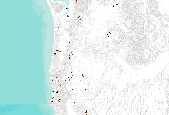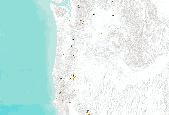Filters: Tags: populations (X)
15 results (79ms)|
Filters
Contacts
(Less)
|

The Institute for Bird Populations (IBP) coordinates the Monitoring Avian Productivity and Survivorship (MAPS) Program to assess and monitor the vital rates and population dynamics of North American landbirds. The MAPS Program utilizes a standardized constant-effort mist netting and banding protocol (DeSante et al. 2010) at a continent-wide network of monitoring stations. Each summer dedicated volunteers operate bird-banding stations to collect data on individual "birds-in-the-hand" representing over 200 species. Analyses of MAPS data provide critical information relating to the ecology, conservation, and management of North American landbird populations and the factors responsible for changes in their populations....

The Institute for Bird Populations (IBP) coordinates the Monitoring Avian Productivity and Survivorship (MAPS) Program to assess and monitor the vital rates and population dynamics of North American landbirds. The MAPS Program utilizes a standardized constant-effort mist netting and banding protocol (DeSante et al. 2010) at a continent-wide network of monitoring stations. Each summer dedicated volunteers operate bird-banding stations to collect data on individual "birds-in-the-hand" representing over 200 species. Analyses of MAPS data provide critical information relating to the ecology, conservation, and management of North American landbird populations and the factors responsible for changes in their populations....

The Institute for Bird Populations (IBP) coordinates the Monitoring Avian Productivity and Survivorship (MAPS) Program to assess and monitor the vital rates and population dynamics of North American landbirds. The MAPS Program utilizes a standardized constant-effort mist netting and banding protocol (DeSante et al. 2010) at a continent-wide network of monitoring stations. Each summer dedicated volunteers operate bird-banding stations to collect data on individual "birds-in-the-hand" representing over 200 species. Analyses of MAPS data provide critical information relating to the ecology, conservation, and management of North American landbird populations and the factors responsible for changes in their populations.

The Institute for Bird Populations (IBP) coordinates the Monitoring Avian Productivity and Survivorship (MAPS) Program to assess and monitor the vital rates and population dynamics of North American landbirds. The MAPS Program utilizes a standardized constant-effort mist netting and banding protocol (DeSante et al. 2010) at a continent-wide network of monitoring stations. Each summer dedicated volunteers operate bird-banding stations to collect data on individual "birds-in-the-hand" representing over 200 species. Analyses of MAPS data provide critical information relating to the ecology, conservation, and management of North American landbird populations and the factors responsible for changes in their populations....

The Institute for Bird Populations (IBP) coordinates the Monitoring Avian Productivity and Survivorship (MAPS) Program to assess and monitor the vital rates and population dynamics of North American landbirds. The MAPS Program utilizes a standardized constant-effort mist netting and banding protocol (DeSante et al. 2010) at a continent-wide network of monitoring stations. Each summer dedicated volunteers operate bird-banding stations to collect data on individual "birds-in-the-hand" representing over 200 species. Analyses of MAPS data provide critical information relating to the ecology, conservation, and management of North American landbird populations and the factors responsible for changes in their populations....
Superseded by the GRSG 2015 USFWS Status Review Base Data Population dataset. This layer produced through collaborative work done by the 2012 Sage-Grouse Conservation Objectives Team (COT). The COT consisted of State and FWS representatives tasked with developing conservation objectives by defining the degree to which the threats to Sage-Grouse need to be ameliorated to conserve the Sage-Grouse so that it is no longer in danger of extinction or likely to become in danger of extinction. This data layer represents Sage-Grouse populations as defined by the COT. Population polygons provide a general identification of important areas for Sage-Grouse across its range. The population polygons originated from the Schroder,...
Categories: Data;
Types: Downloadable,
Map Service,
OGC WFS Layer,
OGC WMS Layer,
Shapefile;
Tags: California,
Colorado,
Greater Sage-grouse,
Idaho,
Montana,

The Institute for Bird Populations (IBP) coordinates the Monitoring Avian Productivity and Survivorship (MAPS) Program to assess and monitor the vital rates and population dynamics of North American landbirds. The MAPS Program utilizes a standardized constant-effort mist netting and banding protocol (DeSante et al. 2010) at a continent-wide network of monitoring stations. Each summer dedicated volunteers operate bird-banding stations to collect data on individual "birds-in-the-hand" representing over 200 species. Analyses of MAPS data provide critical information relating to the ecology, conservation, and management of North American landbird populations and the factors responsible for changes in their populations....

The Institute for Bird Populations (IBP) coordinates the Monitoring Avian Productivity and Survivorship (MAPS) Program to assess and monitor the vital rates and population dynamics of North American landbirds. The MAPS Program utilizes a standardized constant-effort mist netting and banding protocol (DeSante et al. 2010) at a continent-wide network of monitoring stations. Each summer dedicated volunteers operate bird-banding stations to collect data on individual "birds-in-the-hand" representing over 200 species. Analyses of MAPS data provide critical information relating to the ecology, conservation, and management of North American landbird populations and the factors responsible for changes in their populations.
This data set represents greater sage-grouse populations to be used in work for the US Fish and Wildlife (USFWS) 2015 Status Review for the greater sage-grouse. Populations do not represent occupied habitat. Population polygons are meant to coarsely identify areas of occupation based on encircling groups of leks. Boundaries taken from BLM/WAFWA revised population boundaries (‘COT_SG_Populations_2014_WAFWA_UT’ data layer). The original data layer was slightly modified for the USFWS 2015 Status Review. Modifications include dissolving populations across State boundaries and merging several polygons together. Five additional polygons were added to the data set including four polygons in Utah and one polygon in Canada....
Categories: Data;
Types: ArcGIS REST Map Service,
Map Service;
Tags: GRSG 2015 US FWS Status Review,
Greater sage-grouse,
Greater sage-grouse,
Populations,
populations,

Pacific Northwest MAPS Vizband Diversity Model Parameter Estimates Term Estimate Std Error t Ratio Prob>|t| Intercept 35.908117 1.821534 19.71 <.0001 ELEVMET 0.0088 0.001203 7.32 <.0001 can123_2k -0.1238 0.029042 -4.26 <.0001
This data set represents a preliminary attempt to define distinct areas of Sage-grouse occupation in North America. The 'boundaries' for subpopulations are not actually boundaries, but lines meant to encircle a specific group of leks. The difference may seem trivial, but it is significant. We did not establish an area associated with each population or subpopulation, and consequently we did not evaluate the associated habitat and/or landscape. This type of analysis would have required a specific assessment of the habitat within and between each of the identified populations and subpopulations. The descriptions of subpopulations are clearly a preliminary attempt to define distinct areas of occupation.
Habitat and population fragmentation were considered as one of the top factors contributing to the recent U.S. Fish and Wildlife Service decision that listing greater sage-grouse was warranted but currently precluded. This study provides an approach that combines genetic markers and landscape analyses to delineate populations, estimate fragmentation and connectivity in sage-grouse populations, and potentially identify underlying causes that limit connectivity and isolate populations. State and federal agencies are focusing current management actions for greater sage-grouse in core areas containing the highest densities of breeding birds. The core area approach permits limited resources to be applied in regions that...
Categories: Publication;
Types: Citation;
Tags: Birds,
Genetics,
Grasslands and Plains,
Landscapes,
Northwest CASC,
Ictalurid populations, including those of the Neosho madtom,Noturus placidus, have been monitored in the Neosho River basin since theU.S. Fish and Wildlife Service listed the Neosho madtom as threatened in1991. The Neosho madtom presently occurs only in the Neosho River basin,whose hydrologic regime, physical habitat, and water quality have beenaltered by the construction and operation of reservoirs.
These data sets represent our preliminary attempt to define distinct areas of Sage-grouse occupation in North America.
Categories: Data;
Types: Downloadable,
Map Service,
OGC WFS Layer,
OGC WMS Layer,
Shapefile;
Tags: Alberta,
California,
Canada,
Centrocercus,
Colorado,
|

|